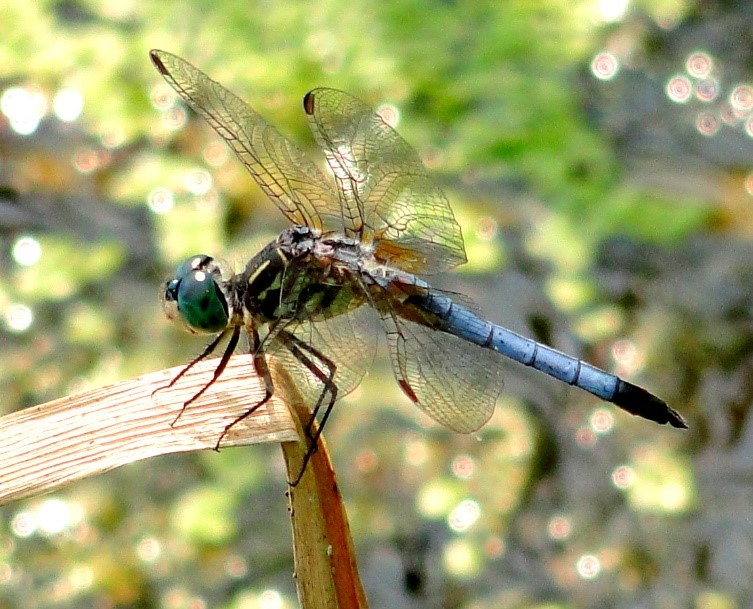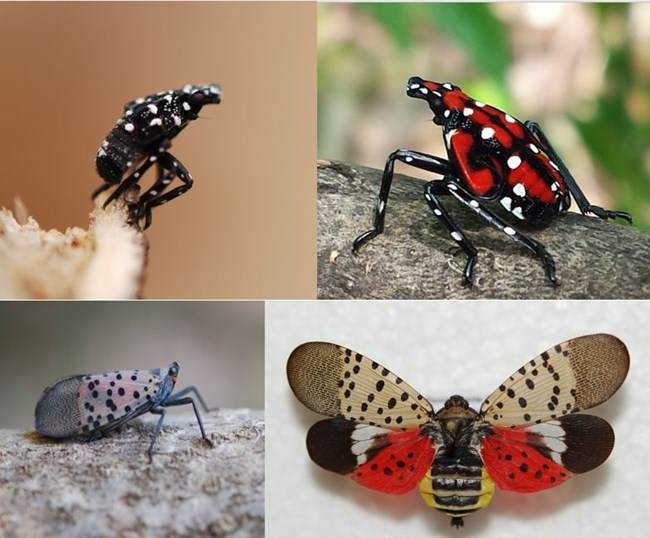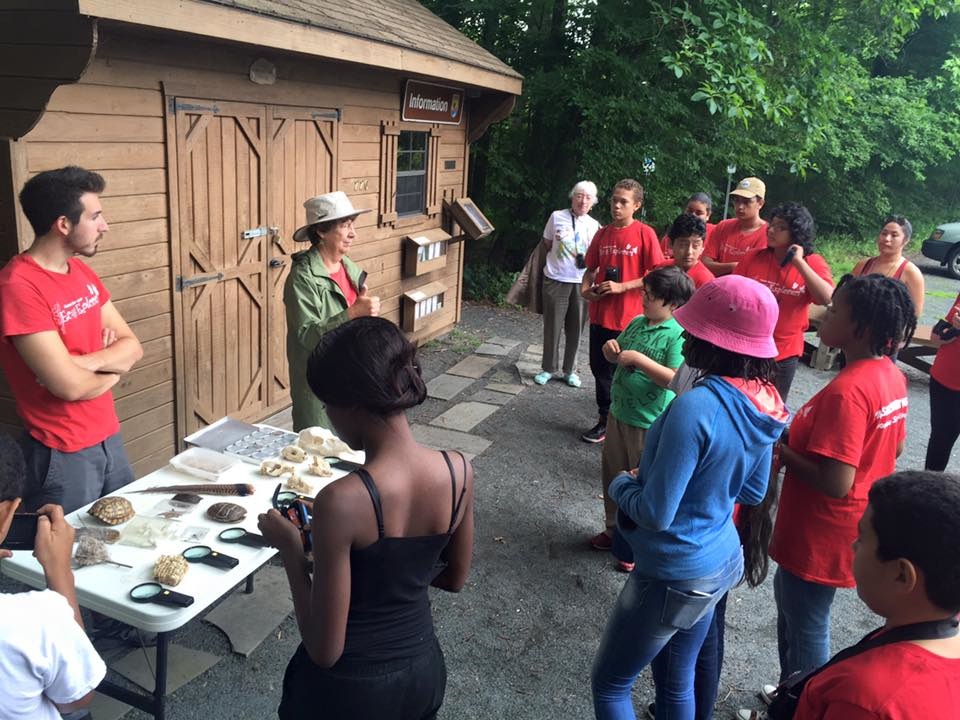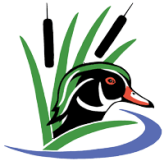
Dragonflies are not a pesky insect! On the contrary, they devour insect pests, eating hundreds of mosquitoes, biting flies and gnats a day. Bring on the Mosquito Hawks!
This is an amazing insect. They are among the fastest and most agile of flying insects. They can hover motionless, fly upside down or backwards, and change tack in a blink.
Nearly all of a dragonfly’s head is eye – their enormous, compound eyes allow for nearly 360 degree vision. They locate, chase, catch and eat insects on the wing, grabbing their prey with their feet. They are deadly hunters (if you’re an insect), catching up to 95% of their prey every time.
They begin life in an aquatic larval stage and are an important food source for larger aquatic animals such as fish. The dragonfly larvae require clean water – just like us – and their presence indicates a healthy water supply.
Dragonflies do not bite or sting humans. But if you lived 320 million years ago, you might duck if you saw one coming as the ancient dragonflies had a wingspan of 24 inches – wow! two feet!
And that’s not all that’s amazing about dragonflies. To learn more fascinating facts, pick up some identification tips, and ask all your dragonfly questions, join Friends volunteers Corinne Errico and Paul Lauber on Sunday, July 10 at 1:30 pm for a fascinating program called Behold the Dragonfly! This will be a hybrid program, both in-person in the Pavilion at the Helen C. Fenske Visitor Center and virtually on Zoom. Registration is required for both. Sign up here.

Over the winter, we all tried hard to locate and destroy egg masses of the invasive Spotted Lanternfly, but guaranteed, we missed some! They are hatching now and will soon be visible as tiny black and white spotted nymphs. During their fourth stage, before reaching adulthood in July, they increase in size and develop red coloration with white dots and black stripes.
This is a highly invasive and destructive insect which feeds on the sap of many hardwood trees, shrubs, ornamental plants which may stress and weaken them. As the insect sucks sap, it excretes a sticky substance called honeydew which impacts agricultural crops of economic importance such as grapes, apples, and hops.
What more can we do? There are traps available which should be placed around tree trunks to capture the adult lanternflies. There are also traps you should not use, like sticky traps, which can kill beneficial insects and even birds.
Watch our website for a future program where we will demonstrate assembling appropriate and effective traps and where you can learn more about this destructive insect and ways you can make a difference.
Volunteers are once again offering guided tours, upon request, to welcome and educate visitors. Walk leaders are knowledgeable about the geology and history of the Refuge, well as the plants, animals and ecology of the Swamp and can customize a tour to accommodate a range of interests and age groups. In addition to school and civic groups, walks can be arranged for senior citizens, home-schooled students, wedding guests, class-reunions and other groups.
There is no charge for tours, although donations are graciously accepted by Friends of Great Swamp NWR, the 501(c)3 that supports the Refuge and recruits and trains the volunteers.
Spring is a great time to see migrating song birds, emerging wildflowers, snakes, frogs and turtles. Fall brings good weather, great autumn colors, butterflies, and migrating waterfowl. But a walk in the Refuge at any time of the year reveals the unexpected. The walks are approximately 1.5 hours long and are either at the Wildlife Observation Center or the Visitor Center. For more details and to schedule a walk, please contact Jared Green Jared_Green@fws.gov.

Sponsored by Friends of Great Swamp National Wildlife Refuge

Photo by Spencer Duncan 2020
Enter the 2022 Refuge Photo Contest and share your special moments captured at the Great Swamp National Wildlife Refuge!
All amateur photographers are invited to submit up to a total of five digital photos spanning the categories below. All photos must be taken within the Great Swamp National Wildlife Refuge boundaries.
Categories include:
-
-
- Raptors
- Birds Other than Raptors
- Pollinators, Other Insects and Spiders
- Any Other Wildlife
- Scenics & Natural Design
- Plants & Fungi
- Youth – any subject, age 16 or younger
-
Putting the well-being of wildlife first must be every photographer’s aim. The Friends strongly support the North American Nature Photography Association (NANPA) Principles of Ethical Field Practice. This means always putting the welfare of the subject before yourself or the photograph.
Deadline for submissions is July 4, 2022. Please read all contest rules carefully on the submission form available under the photo contest menu on the Friends website.
Winning entries will be announced at a special presentation event to be held in the fall of 2022.
Start Snapping!
 A Zoom Second Sunday with Friends of Great Swamp National Wildlife Refuge
A Zoom Second Sunday with Friends of Great Swamp National Wildlife Refuge
Sunday, March 13, 1:30-3:00 pm
Even if you’ve never seen a coyote – chances are, they have seen you!
• Coyotes are found in every county in New Jersey and nearly every corner of North America. And not just in rural areas—they are found in suburbs and thrive in cities!
• They are nocturnal predators and are not picky! They will eat just about anything.
• Coyotes can run fast and are very vocal using yips, barks and howls to communicate.
Join Somerset County Parks Naturalist Vanessa Darras to learn more about this intelligent and adaptable animal. She’ll help us sort the myths from the facts.
REGISTRATION IS REQUIRED
Sign up at ttsu.me/coyote or from the Events page on the Friends website. The Zoom logon will be sent to all registrants at Noon on Sunday, March 13.
Sponsored by Friends of Great Swamp NWR with generous support from the Marta Heflin Foundation

Join us for three days of birding fun
February 18 – 20, 2022
The Great Backyard Bird Count (GBBC) is an international event that is free, fun and easy for everyone. It engages bird watchers of all ages and skill levels in counting birds to create a real-time snapshot of bird populations around the world.
Feeder Count from inside the Visitor Center
Volunteers will be counting birds at the feeders from inside the Visitor Center every day (February 18th – 20th) from 10:00 am to 2:00 pm. Visitors are invited to help with the count. Stop by for a few minutes – or more. For novice birders, volunteers will teach you how to identify the common feeder birds. We will practice social distancing and masks are required.
Special GBBC Winter Walk
Friday, February 18, 11:00 am–12:30 pm
In addition to our regular Winter Walk, volunteer Paul Lauber will lead a GBBC Bird Walk to count all the birds seen, and heard, along Pleasant Plains Road. Dress warmly and bring binoculars; masks are recommended. You may leave the walk at any time. Download Cornell’s free Merlin Bird ID app before you come to help identify birds by sound.
Daily bird counts from the feeders and the walk will be reported to the Cornell Lab of Ornithology for scientists to use for research and education. Your participation will be helping these professionals learn more about how birds are doing, and how to protect them and the environment we share.
For more information, check out the Great Backyard Bird Count website: birdcount.org. There’s a link there to sign up for a free GBBC Webinar on Wednesday, February 16, 2:00 pm to brush up on bird ID and practice counting birds. You are encouraged to do a bird count from your own home as well.

